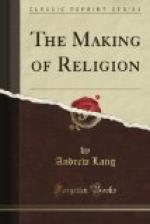In any case, early man excogitated (by the hypothesis) the abstract idea of Life, before he first ‘envisaged’ it in material terms as ‘breath,’ or ‘shadow.’ He next decided that mere breath or shadow was not only identical with the more abstract conception of Life, but could also take on forms as real and full-bodied as, to him, are the hallucinations of dream or waking vision. His reasoning appears to have proceeded from the more abstract (the idea of Life) to the more concrete, to the life first shadowy and vaporous, then clothed in the very aspect of the real man.
Mr. Tylor has thus (whether we follow his logic or not) provided man with a theory of active, intelligent, separable souls, which can survive the death of the body. At this theory early man arrived by speculations on the nature of life, and on the causes of phantasms of the dead or living beheld in ‘dreams and visions.’ But our author by no means leaves out of sight the effects of alleged supernormal phenomena believed in by savages, with their parallels in modern civilisation. These supernormal phenomena, whether real or illusory, are, he conceives, facts in that mass of experiences from which savages constructed their belief in separable, enduring, intelligent souls or ghosts, the foundation of religion.
While we are, perhaps owing to our own want of capacity, puzzled by what seem to be two kinds of early philosophy—(1) a sort of instinctive or unreasoned belief in universal animation, which Mr. Spencer calls ‘Animism’ and does not believe in, (2) the reasoned belief in separable and surviving souls of men (and in things), which Mr. Spencer believes in, and Mr. Tylor calls ’Animism’—we must also note another difficulty. Mr. Tylor may seem to be taking it for granted that the earliest, remote, unknown thinkers on life and the soul were existing on the same psychical plane as we ourselves, or, at least, as modern savages. Between modern savages and ourselves, in this regard, he takes certain differences, but takes none between modern savages and the remote founders of religion.
Thus Mr. Tylor observes:
’The condition of the modern ghost-seer, whose imagination passes on such slight excitement into positive hallucination, is rather the rule than the exception among uncultured and intensely imaginative tribes, whose minds may be thrown off their balance by a touch, a word, a gesture, an unaccustomed noise.’[18]
I find evidence that low contemporary savages are not great ghost-seers, and, again, I cannot quite accept Mr. Tylor’s psychology of the ’modern ghost-seer.’ Most such favoured persons whom I have known were steady, unimaginative, unexcitable people, with just one odd experience. Lord Tennyson, too, after sleeping in the bed of his recently lost father on purpose to see his ghost, decided that ghosts ’are not seen by imaginative people.’




